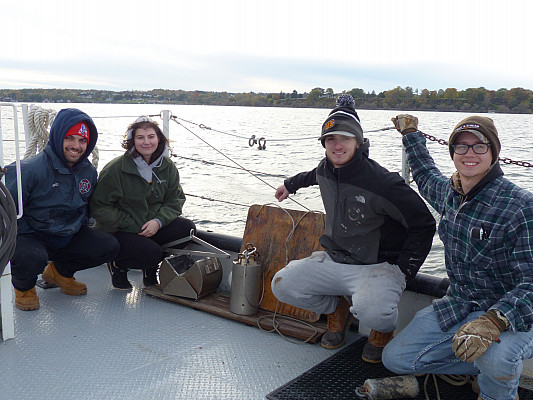
Research at Sea
Bundled up in warm coats, Associate Professor of Environmental Studies Leah Joseph and four Ursinus students set sail aboard a research vessel on chilly Seneca Lake in October to get hands-on experience taking sediment cores.
The students in Joseph’s Global Climate Change course (Amanda White ’20, Cody Meikrantz ’21, Jake Twill ’20, and Sebastian Khidhayir-Greco ’19), typically will spend a portion of their lab time learning about different types of climate records. One of the ways researchers gather data on the subject is by analyzing sediment samples.
“Sediment accumulates through time and can record some of the conditions under which it was deposited,” Joseph explains.
Seneca Lake, one of the glacial Finger Lakes in upstate New York, was the perfect location for the students to apply some of their classroom knowledge out in the field on a research trip. They boarded “The William Scandling,” a 65-foot, steel hulled research vessel where they were able to utilize the ship’s equipment.
Before the trip, the students worked lab to examine climate and climate change by studying temperature and sea level records from the near-present day to oxygen isotopes and sediment records from the older parts of the Cenozoic era.
Students then collected their own sediment cores on the research vessel by puncturing into the sediment at the bottom of the lake using a method called piston coring. It allowed them to bring a 10-foot core on board.
“It’s a relatively unique experience to do research on board a ship and use scientific equipment to collect sediment cores,” Joseph says. “Part of the excitement is being able to see first hand what it takes to collect just one core for one study. There’s real value in gaining hands-on experience with real samples and real data.”
Joseph also explained that the trip—and the overall project—is a great way for students to learn that science can have its challenges. It takes time to do research, equipment may not always work the way you want it to, and sometimes, you get unexpected results.
“We’ve been learning a lot about different ways that scientists study climate and it was awesome to be able to actually carry out this process on our own,” Twill says. “Other than operating some of the heavy machinery on the research vessel, my classmates and I carried out the rest of the coring process, which was very cool. Learning about how scientists and researchers extract this data is interesting, but doing it yourself offers a unique experience that we could not get otherwise.”
Once the core was carefully brought back home, the analysis began. Students are studying it for variations in magnetic susceptibility, grain size, carbonate content and color. Each of these elements can tell something different about the environment and climate back when the sediment was deposited.
“Our goal was to capture a core that shows the latest transition from the last glacial period to our current interglacial period, which occurred approximately 12,000 years ago,” White explained. “The newer sediment—interglacial—was an olive gray/black, while the sediment from the last glacial period is a pinkish gray color. We were able to capture a small section of the transition between these two periods.”
Research and analysis of the sediment core is still ongoing. Joseph hopes that the experience will help her students better understand what they have been talking about in class now that they have been able to participate in the process first-hand. Being able to see, touch and even smell the sample on the table in front of them instead of reading a description from the pages of a textbook can make a huge difference in how they understand the information they have gathered. —By Mary Lobo ’15
